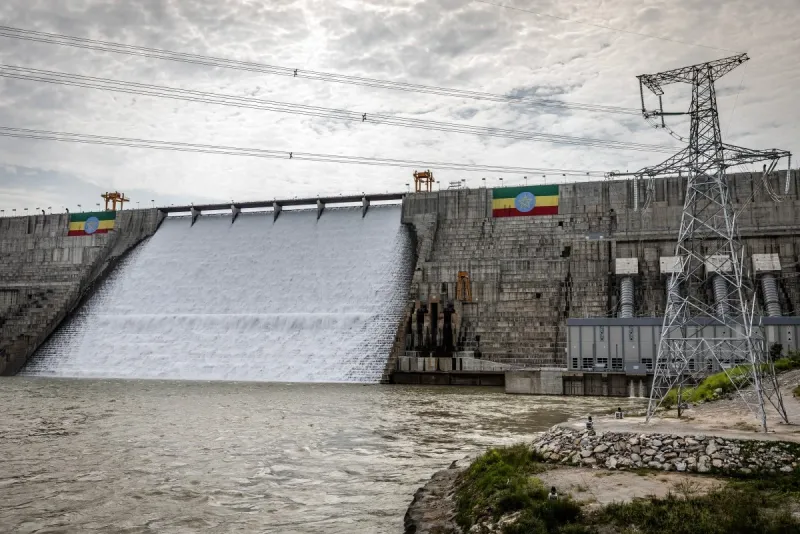Nothing better attests to the sublime power of nature than an earthquake. In the mere blink of an eye, and with minimal warning, the earth unleashes incomparable forces. A civilization's best-laid foundations can be leveled in a heartbeat. Buildings often come crashing down, crushing people and destroying cultural heritage, in the tumble of stones and debris. For example, the Kashmir earthquake of October 2005 measured 7.6 on the Richter scale. It destroyed more than 30,000 structures and killed roughly 79,000 people (via Britannica). And in China, the Sichuan earthquake of 2008 rendered 5 million people homeless almost instantaneously, with a jolt measuring 7.9.
Other devastating seismic shakes (sometimes coupled with tsunamis) have taken place in Haiti, Peru, Japan, and the Indian Ocean basin in recent years. Because these natural disasters prove so hard to predict, when they hit highly populated areas, they leave an unrivaled path of destruction in their wake. What's more, when the ground starts to rumble and roll, finding a safe space to escape to can prove challenging to say the least.
But when it comes to the deadliest day in human history, one event stands out from the rest — the 16th-century tremor that wreaked havoc on the "Cradle of Chinese Civilization" in the provinces of Shaanxi and Shanxi. This tremor created a domino effect of natural disasters that would wound the very heart and soul of Imperial China. Here's what you need to know about this catastrophic moment in human history and its shocking aftermath.
Quantifying the importance of central China, and more specifically the provinces of Shaanxi and Shanxi, to the development of Chinese civilization is difficult. The Centre for Liveable Cities explains that Shaanxi boasted Xi'an, a flourishing capital that served as the seat of imperial administration for 13 dynasties. But the magnetic allure of the metropolitan center didn't end there.
Xi'an also represented a launching off point for the Silk Road, connecting a network of trade routes stretching from the Middle East to Central Asia and other regions in China. Located on the Weihe River, the area contains countless archaeological sites. The oldest of these dates back to 600,000 years ago when Neolithic communities first embraced agriculture, adopting a sedentary lifestyle in the process. By the Middle Ages, Xi'an was renowned as one of the largest metropolises worldwide.
As China.org notes, many refer to Xi'an and surrounding Shaanxi as the "cradle of Chinese civilization," and with good reason. This area contains incredible artifacts and monuments to prove its claim to that title, from the Greater Wild Goose Pagoda in Dayanta to the Forest Stelae of Beilin and the Bell Tower at Zhonglou. But perhaps the most famed historic site in the region remains the Terracotta Army of Qin Shi Huang, a collection of life-sized warriors in full battle array, prepared to perpetually guard the Qin emperor's tomb. But despite all the advancements in Shaanxi and Shanxi, neither province proved invincible when it came to natural disasters, a vulnerability shared with contemporary settlements today.
On January 23, 1556, a massive earthquake and aftershocks rocked the prosperity of Shaanxi and Shanxi provinces, as reported by History. In the aftermath of the seismic catastrophe, a chain of events including fires, ground fissures, landslides, and mudslides contributed to an unfathomable death toll. For those who survived the event, they experienced one living nightmare after another, representing a perfect storm of destruction.
While estimating casualty figures from so long ago proves notoriously difficult, most scholars agree that roughly 830,000 people perished, making it an event of unprecedented carnage and "the deadliest of all time." To provide some context for this number, consider the death toll attributed to the American Civil War, by far the bloodiest conflict the nation has ever fought. Recently revised figures put the final casualty count at 750,000 over four years (via the BBC). Now add 80,000 to the figure and shrink the time frame majorly, and you start to grasp the magnitude of the tragic events in Shaanxi and Shanxi.
What's most alarming about this natural disaster is the fact the initial tremors only lasted a few seconds, per History Collection. Yet, the incredible force contributed to a deadly domino effect that completely devastated the region and local populations. While other earthquakes have proven higher on the Richter scale, this doesn't negate the fact that none of those killed as many people.
Emperor Jiajing of the Ming dynasty led Imperial China at the time (via Britannica). So, many call it the Jiajing Earthquake, per History Collection. Mired in corruption and bureaucracy, the last thing on Jiajing's mind was earthquake preparedness. What's more, Shaanxi and Shanxi's dense population concentrations contributed to tremendous loss of life. Commoners lived in unstable housing that could not endure the shaking of the event. Central China featured a type of architecture that was anything but quake-proof. Many people converted caverns of loess into lodgings or carved cliffside homes from the silty sediment. Loess stayed cool in the summer and mild in the winter. It also proved temptingly easy to work with.
National Geographic defines loess as a "fine, mineral-rich material" that can be created by various natural forces, including wind and glaciers. Carried as fine, powdery sediment down streams and other waterways, it can range in thickness from a few inches to hundreds of feet. This pale substance remains loosely packed, making it ideal for relatively easy carving out, and yet it tends to retain its form making for robust walls.
Convenience aside, however, it represented the equivalent of building a home on a sand foundation. These residences, known as yaodongs, disintegrated due to the magnitude 8.1 to 8.4 tremors, transforming from shelters into veritable death traps. And the loss of these poorly constructed yaodongs marked just the tip of the iceberg when it came to shake-induced regional devastation.
Loess structures alone weren't to blame for all the damage. According to History, major cities in the area boasted many structures constructed from blocks of stone. Unfortunately, these stones rained down on people during the earthquake, crushing and killing them. Historical records tell us that cities such as Huayin, Huaxian, and Weinan saw every single building crumble within their civic limits.
According to the History Collection, the annals of China describe the quake and its aftermath this way: "Mountains and rivers changed places and roads were destroyed. In some places, the ground suddenly rose up and formed new hills, or it sank abruptly and became new valleys. In some areas, a stream burst out in an instant, or the ground broke and new gullies appeared." Needless to say, most structures in the vicinity never stood a chance.
A lack of technology and resources made rescue efforts tricky at best and treacherous to impossible at worst. What's more, the region experienced aftershocks for upwards of six months, which further destabilized buildings and landscapes. These residual tremors shattered the remaining residents' nerves and impeded recovery and reconstruction efforts. To better understand just how significant the damage proved, it's helpful to place it within a modern context. Consider the financial and political devastation, the loss of life, and the nation-crushing capacity of a natural disaster that destroyed the United States' Mid-Atlantic region. Likewise, the very heart of Imperial China was destroyed in 1556.
Where did the earthquake originate? Near Huaxian in the Weihe (Wei) River Valley, according to History. But the destruction encompassed a 200-mile radius, destroying many neighboring villages and free-standing houses. And some records even logged damage in excess of 300 miles away.
What ultimately caused the earthquake? Most scholars cite three active fault lines in the area as culprits. The annals of China note that of the 26 tremors described in official records, all had epicenters in the Weihe River basin, per Britannica. Of course, China has never been a stranger to seismic disasters. For example, a quarter of a million people perished in earthquakes during the 1970s. But what did the geological activity look like on that fateful day in 1556? Researchers continue to put forth hypotheses, and no doubt, our understanding of the disaster will expand as scientists continue to analyze and explore the region's seismic past.
Nevertheless, a few facts are undeniable. According to the Journal of Geophysical Research, "the greatest levels of shaking (XI+ to XII) were experienced in the Huaxian and Weinan regions, suggesting that the earthquake ruptured the nearby Huashan and Weinan faults." Some researchers believe steep slopes, known as scarps and still visible in the region today, are reminders of this disaster and its incredible force.
MAJOR CITIES WERE LEVELED AND DEPOPULATED
Metropolitan areas located near the Weihe (Wei) River Basin fared terribly during the jolt, with roughly half the population perishing in their residences. What's more, the two primary provinces impacted by the tremor, Shaanxi and Shanxi, lost 60% of their total populations, as reported by History. Naysayers claim these figures have been exaggerated. Nevertheless, the reality is that even if they were a bit of an overestimate, it would still be the most deadly earthquake, easily.
According to the Journal of Geophysical Research, researchers believe one-third of these casualties died as a direct result of the earthquake and its aftermath, including massive flooding, fires, and landslides. As for the other two-thirds? They perished from famine due to the tremendous path of destruction carved by the event.
Moreover, Shaanxi and Shanxi's disaster proved uniquely damaging to Imperial China as a whole. Apart from the terrible destructive force of the disaster, the lack of quake-proof infrastructure, and people crammed in close quarters, other factors contributed to instability, both politically and financially. The Chinese Empire struggled with many issues, including the inhumanity of Emperor Jiajing's reign, the deterioration of the nation's borders under threat of Mongolian nomads, and much more (via Britannica). According to History Collection, the seismic disaster had incalculable impacts on the Ming Dynasty, weakening sovereignty and impoverishing the Imperial Treasury.
IRREPARABLE CULTURAL DAMAGE TOOK PLACE
HelloRF Zcool/Shutterstock
Besides a massive death toll, the quake also did irreparable damage to important cultural resources, such as the Small Wild Goose Pagoda. Built between 707 and 710 A.D., the Small Wild Goose Pagoda was erected during the Tang Dynasty under Emperor Zhongzong (via the University of Michigan).
One of two vital pagodas in Xi'an (the other being the Giant Wild Goose Pagoda), the Small Wild Goose Pagoda features a square base and sturdy brick frame that proved more resilient during the tremor than many other local buildings. That said, during the earthquake, the Small Wild Goose Pagoda's top collapsed, resulting in a loss of six feet in height (via History Collection).
What's more, 40 of the 114 stone tablets of the iconic Tang Stone Classics were broken or damaged, according to Umberto Bresciani, author of "Confucian Holy Places." These tablets, also known as the Kaicheng Stone Classics, were located at the Stele Forest Museum. They represented the "earliest official stone inscriptions of Confucian classics," containing an incredible 650,000 characters (via Shine). Besides the damage to the tablets, various other artifacts also got destroyed during the natural disaster, representing an impoverishing of local cultural heritage.
LESSONS LEARNED AND APPLIED IN THE QUAKE'S AFTERMATH
JUN YANG/Shutterstock
After the earthquake, survivors in the region sought better, more quake-proof approaches to construction. These included wood and bamboo, both cost-effective and readily available building materials. Dabbling with these construction materials came with varying degrees of success. But both proved robust enough to find applications into the present.
According to World Bamboo, "Bamboo is used as a predominant structural member and bamboo frame as a predominant structural system, during earthquakes." Because of the introduction of wooden and bamboo structures, many people forsook loess caves for above-ground dwellings more resistant to tremors. And it's easy to understand why when you consider the horror survivors witnessed during the earthquake as massive mudslides crashed into cliffside dwellings, faltering under the fury of the seismic jolt (via the Los Angeles Times).
Surprisingly, though, millions of Chinese still live in yaodongs to this day. Despite the lessons learned at Shaanxi, impoverished individuals have few options. What's more, cave dwellings have a downright ancient history: "The cave topology is one of the earliest human architectural forms ... What is unique to China is the ongoing history it has had over two millenniums." Although buyers should beware when it comes to purchasing a yaodong in a seismically active area, cave dwellings come with some fantastic features. These include affordability, energy efficiency, and strategic land conservation (since arable land remains free from above-ground structures).
CAUGHT IN A SEISMIC TWIST
Meiqianbao/Shutterstock
The Weihe Basin contains many active faults that have contributed to earthquakes over the centuries, according to IOP Science. Today, scientists are relying on GPS data to help measure slip rates along fault lines in the basin. This research could help residents better prepare for future seismic events. And it could provide greater insight into the shaking that wreaked so much havoc in 1556.
What have they found so far? Research shows that the "Weihe Basin belongs to a fault block that is strongly twisted and tilted ... The central part ... is the deepest twisted zone in the basin, and its east, west, south, and north boundaries are all composed of stepped normal faults sloping toward the middle of the basin." Scientists have also concluded that the slip rates of the Weihe fault prove significantly high. That's no surprise for anyone who has studied the history of the area.
Better fleshing out how the deadliest day in history unfolded will require continued and careful seismic analysis. When you consider the fact that the population of Xi'an, Shaanxi, now boasts 8,274,651 people, another event like that of the 16th century would contribute to tremendous loss of life (via the World Population Review). That's why it's of the utmost importance that researchers gain a greater understanding of how earthquakes happen, how to predict them, and how better to prepare for them.
LIFE IN EARTHQUAKE PRONE ZONES
fansheng/Shutterstock
Reflecting on the terrible tragedy in central China in 1556, it's disheartening to realize we've made little progress when it comes to predicting earthquakes. Scientists continue to work hard at cracking this geological code. An increased sense of urgency exists for those living in the path of previous tremors, such as Shaanxi and Shanxi provinces. New Scientist explains, "For places with a high rate of historical activity, the chance that a quake will hit in a future period of several decades can be quite high." What's more, highly active fault zones come with the looming threat of future events, decades and even centuries down the road.
Which signals are seismologists examining? They've studied various potential predictors, including measurable geochemical disruptions in groundwater, radon gas concentration shifts, the presence and magnitude of foreshocks, and indications of geological deformation or warping on the surface of the Earth. Some researchers have even delved into animal behavior, looking for telltale signs a quake is about to hit. While innovative in their scope and reach, none of these approaches has proven accurate when it comes to predicting future events. This leaves people living in historically active seismic regions on shaky ground, literally.
With all the progress made in science, why can't we find a better way to tell when a quake is near? Because earthquakes don't come with reliable symptoms or precursors. As a result, from central China to Southern California, residents live with the potential for unpredictable disasters located beneath their feet.
SOURCE : Grunge




